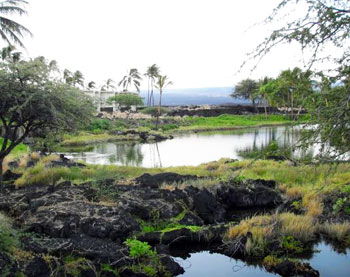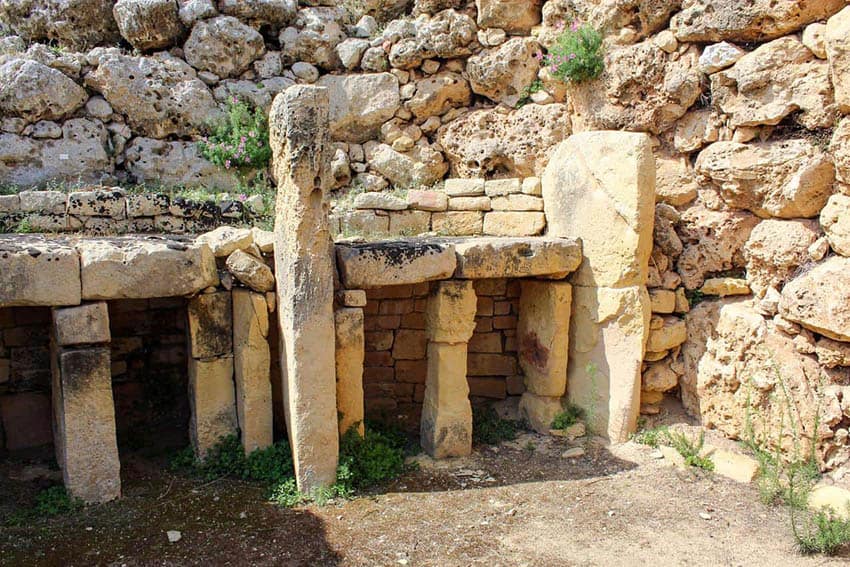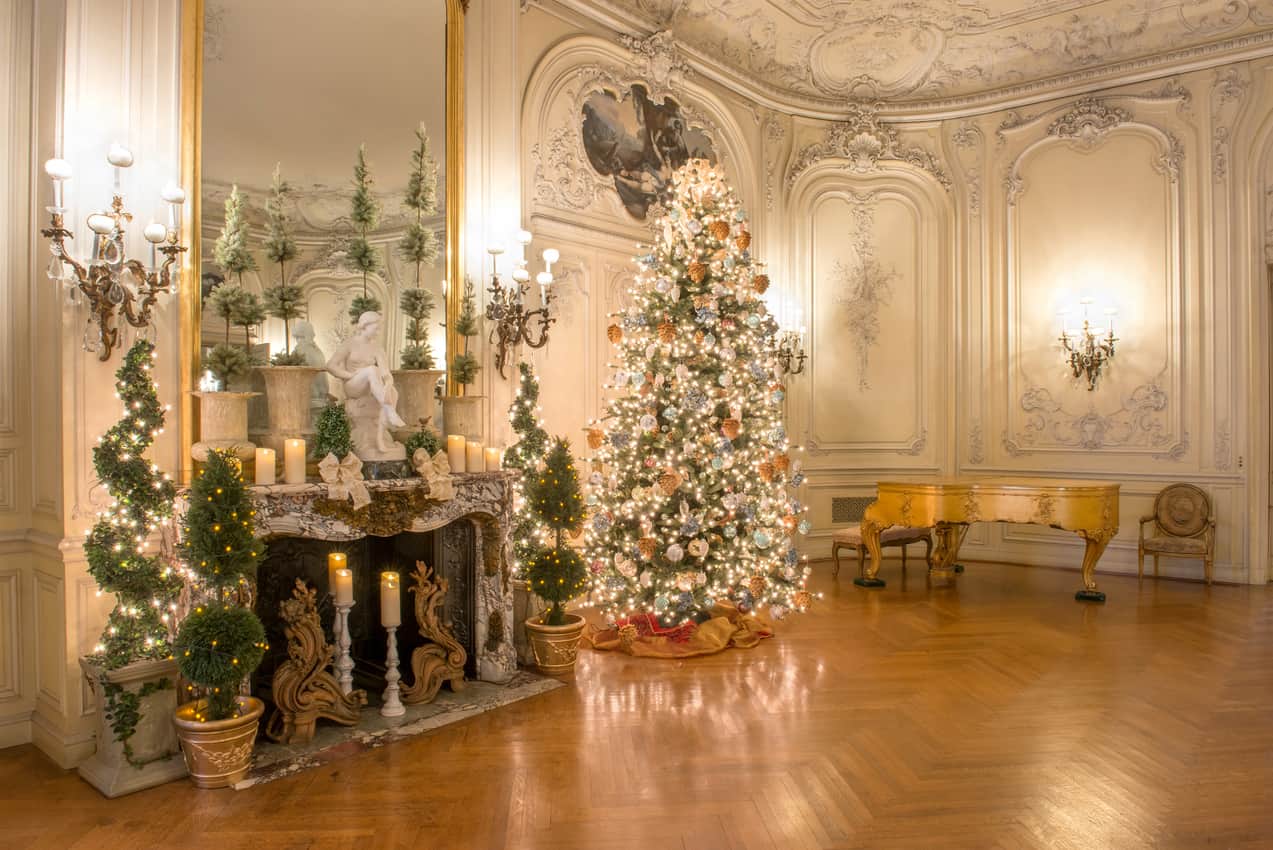Observatories atop Mauna Kea on Hawaii’s Big Island. Photos by Gary Singh.

By Gary Singh
On the Island of Hawai’i, also known as the Big Island, the Mauna Kea Access Road slithers its way past the visitor’s station and up to a dozen observatories at 13,790 feet above sea level. Fourteen of us are comfortably crammed in a four-wheel-drive shuttle piloted by Jon Knight of Hawaii Forest & Trail.
As we weave and bob our way up the lava-shrouded mountain — it resembles the moon, they all say — our driver, to break the ice, poses a question to each of us.
“What is your passion in life?” Jon asks from behind the wheel.
One of the Japanese female tourists at the back of the van says, “Bon Jovi,” stretching out the end, so it sounds like “Bon Joveeeeeeeee.”

I definitely feel somewhere between East and West. For example, the Visitor Information Station at 9,300 feet above sea level sells miso soup packets and bumper stickers that say, “Beware of Invisible Cows.” Apparently dark-colored bovines often emerge on the road, unbeknownst to drivers. It gets a little hairy sometimes.
Upon reaching the summit, we now exist above everything and gaze down at the clouds, far below us. The sun sets, blasting a tangerine wave across the horizon, and the temperature plummets to about 25 degrees Fahrenheit. I am at the top of the world, looking down on evolution.
Diverse Energies
Variety runs deep here. Across the entire landmass, one can traipse through 11 of the world’s 13 official climates, from Wet Tropical to Polar Tundra. The 480 miles of roads that snake their way around and through the island will submit any visitor to an entire spectrum of weather changes. For example, the western coast of the island features dry sunny weather, while on the east coast it rains almost every day.
The Big Island is perhaps the most preeminent Hawaiian landmass to infiltrate first and also the best one on which to go native. At the ripe old age of 800,000, it’s the youngest of all the Hawaiian isles, but it was not until a mere 2000 years ago that Polynesian travelers first arrived at Ka Lae, the island’s southern tip, which is now the southernmost point in the United States.
Also on the east side, the slow-paced beach town of Hilo looks like it hasn’t changed in forty years. On the west coast, expansive swaths of land provide home to enormous resort properties and some pretty darn renowned golf courses — all amongst an endless backdrop of black lava.
But aside from all that, Mauna Kea provides my initial point of reference. We perch ourselves at the top of the world, each traveler smothered in a parka supplied by Hawaii Forest & Trail.
Drinking Kava from coconut shells

A seven-hour journey, the expedition begins with Jon driving us up the mountain and then stopping halfway for altitude acclimation and a beef-stew break. After we hang out at the summit, he brings everyone back down to the Visitor Information Station for a hands-on astronomy lecture before returning us to sea level at the end.
One travels through five different climates in just one day. In a sense, the trek functions as a perfect beginning or ending for whatever else one would want to do on The Big Island.
Kava By the Bay
Historic Hilo, Hawaii, is one of those Bayfront towns beautifully languishing in days gone by. People accuse it of being stuck in the past, which is not an insult. Not here, at least.
The farmer’s market packs ‘em in, as does the Tsunami Museum, but I park myself at Bayfront Kava, Coffee and Tea, where women are goo-gooing over a dude named Alan, who pours us Kava in coconut shells. Soft reggae emanates from the house system. Behind the carved wooden bar I scope out what looks like a medieval alchemist’s storage facility — not your typical bar supply stock.

Alan tells me Kava provides a “gentle euphoria” and relieves anxiety, angst and hyperactivity. I immediately reach out for a shell of the stuff before even listening to the rest of what he says.
Kava is one part tranquilizer, one part cognitive liquid psychotherapy, and another part ancient history. Apparently it used to be the drink of royalty. People have consumed it for 3000 years, so I really doubt it poses any of the threats invented by the crooked pharmaceutical industry.There is no alcohol. A medicinal plant generates the main ingredient and Kava essentially tastes like liquefied ginger root soaked in a sweetened stew of peat moss. If one wants, the addition of Hawaiian coconut water deadens the dirt-like taste somewhat. I don’t care either way. I wind up drinking multiple portions.
Alan teaches me traditional celebratory methods of downing Kava. The ritual includes tossing a pinch of the stuff over each shoulder as an offering to the gods. I begin to believe Kava will work more than anything my ADD doctor prescribes.
Thunder on the Mountain
Here in the hills above Kailuna-Kona sits a forest and plantation filled with coffee beans, donkeys, exotic flowers, medicinal tea plants, geese, pigs and rooms of parching machinery. As a cat resembling Morris lounges on a picnic bench next to me, I’m taking in a TV show — I don’t know which one — with the host visiting this same exact location and yakking about composted donkey poop with one of the kingpins at Mountain Thunder Coffee.
John Langenstein at Mountain Thunder Coffee

Like Champagne, one cannot deem anything, “100% Kona,” unless it’s actually from Kona. If you do, you’re a charlatan. Throughout the rest of the civilized world, when one sees Kona coffee on the shelf, it’s usually a blend. For the real deal, one must journey here, to the heavily-forested hills in the northwest quadrant of Hawaii’s Big Island.
John Langenstein, a legend in these parts, effortlessly shepherds me through the forest, swiping branches away from our faces as we navigate the trails. There are pigs, Toulouse geese, invasive ginger crops, dangerous lava tubes and shimmering spider webs everywhere. I learn more about coffee beans in the span of twenty minutes than I’ll ever be able to remember.
This part of the world, believe it or not, isn’t even that preferable for coffee compared to others, but the folks at Mountain Thunder somehow make it all happen. Unfortunately, I don’t have time for the full tour, which provides a glimpse into the entire coffee process — hand weeding, wet-milling, parching, roasting and the whole nine yards — but I am happy with my own personalized bag of beans at the finale. Straight from the industrial roaster, the bag comes labeled however I desire. It normally tips the scales at $55/llb. Pretty high-grade raw material, I say.
Jim Reddekopp of Hawaiian Vanilla soaks vanilla beans in bourbon.

Hawaiian Vanilla Company
Clad in a Hawaiian shirt and tan slacks, Jim Reddekopp holds up a bottle of bourbon like it’s a museum artifact as he waxes poetic about the vanilla beans in the hooch. He lets them soak in the bottle for months at a time.
He then fires off a laundry list of tidbits: Reddekopp bought his first vanilla plant in 1998. His family singlehandedly fosters what seems like an entire industry. Corporate types and their ilk often rent the place out for banquets and travelers often show up for tours. We’re on the eastern and rainy side of the island, so the drizzle begins to come down outside. The entire property smells like — you guessed it — vanilla.
Reddekopp and his family preside over the only vanilla-producing farm in the United States. He and his wife Tracy homeschool all of their five kids, also raising them to work the farm, cook the meals and take care of the property.
Their daughter Emma, 12, already cooks full meals for guests in the dining room. The six year-old pretty much talks like an adult. The complete scenario is fanatically homey — sort of like a rebranding of ‘Father Knows Best’ for the Slow Food generation.

There are reasons why no one else does this. Vanilla is the second most expensive spice in the world, after saffron. Since it’s the only spice that comes from an orchid, the process requires the utmost patience.
Members of the Reddekopp family preparing a meal in the kitchen.

Each orchid blossom must be hand-pollinated when it blooms, which happens once a year, for a period of about four hours. The vines themselves take a few years to grow and the pollination must be accomplished by hand. No machine can do it. Reddekopp says it’s a skill he and his wife have learned through years of trial and error.
“We celebrate failure around here,” he explains with a kooky smile. “If you haven’t failed, you haven’t tried hard enough.”
As Reddekopp schools me on the intricacies of vanilla-based soap, his children emerge from the kitchen, slinging plates of chow for the folks in the dining room. I scope out sandwich after sandwich of vanilla-bourbon citrus-marinated chicken with vanilla-carmelized onions. The meal comes with vanilla mango chutney aioli and vanilla-based barbecue sauce.
“We’re meat lovers, so we get into the barbecue sauce,” he quips.
Gone Fishing
As with Mountain Thunder, all the renowned food magazines have reported on the goings-on at Hawaiian Vanilla Company. Framed copies grace the walls in the dining room. This is true local flavor — the only manufacturer of vanilla soap specifically for people with gardener’s hands.
On the North Kohala Coast, even the high-end resorts seem connected to authentic indigenous culture and ancient Hawaiian history. One doesn’t get the feeling of being stranded in a sterile cookie-cutter resort plopped onto the sand, or being surrounded by Mai-Tai-ed musclehead plastoids looking to ramp it up from their annual vay-cay in Vegas.
The Waikoloa Beach Resort, for example, sits on a gargantuan swath of land incorporating native ecosystems where one can wander around aimlessly and get away from all the other folks who are trying to get away from it all.
Sandwiched on public land in-between the Waikoloa and the beach itself, one finds the Ku’uali’i and Kahapapa Fishponds. The ponds themselves have been legally protected for centuries. Neither the Marriott nor the nearby Hilton is allowed to interfere with them.
A chart showing some of the fish species in the ponds near the Waikoloa Resort

As I skulk through the landscape, the towering coconut trees reflect in the water. The beach is a tranquil retreat — waves don’t exist here — so an early morning stroll provides a natural way to explore territories where kings sailed in on canoes and feasted on the fish.
On this very land, the ancient Hawaiians developed a unique system of aquaculture by building wooden gates across the channels leading from the ponds out to the ocean. The gates allowed small fish to enter the pond from the sea and feed on the vegetation. When the fish became too large to pass through the gates and escape back into the ocean, they became confined and easily netted for food.

All along the trail that swirls through the area, several placards explain the food chain and the varieties of fish that inhabit the ponds. Just like Kava consumption, all activities on this island seem to come with the approval of ancient royalty.
Hitch Your Four-Wheel Drive to a Star
After the sun disappears, we descend back down Mauna Kea to the Visitor’s Center at 9,300 feet. The meat of the Summit and Stars experience concludes here, applicably, with a high-powered telescope.
Guided by Jon’s knowledge of everything in the nighttime sky, we line up for views of Jupiter, the moon and Venus — a combo I didn’t expect.
Directing a red laser pointer up into the sky, Jon points out each of the twelve astrological houses. The moon rises faster than I’ve ever seen it rise, but we can still see the stars with amazing clarity. They seem to explode in the sky.
We then receive instruction on how to spot the North Star, the differences between constellations and asterisms, as well as historical facts about the astronomer Edwin Hubble. The Milky Way Galaxy makes itself visible before our naked eyes.
Temperature-wise, our bodies survive the quick change in altitude, but the parkas remain necessary. A chilly wind still flips in and out and through the landscape, like someone wringing out a blanket. The Japanese tourists appear to feel the cold more than the rest.
A trusted accomplice from the Hilo side of the island shows up to meet us at the stargazing phase of the tour. She brings me a 16-ounce plastic bottle of kava I had secretly requested ahead of time. It doesn’t warm one’s innards the way alcohol would, but somehow it takes the edge off. Maybe it’s all in my head, I don’t know.
Hawaii Forest & TrailBack down to sea level, we return to the beach area about an hour later. Jon dumps off what’s left of the beef stew at the catering facility and returns us to our hotel. I could use more Kava, but I feel like an ancient king.
Bayfront Kava, Coffee & Tea
- Ramones Museum in Berlin, Germany - August 26, 2014
- El Salvador: The Bardo State of Central America - September 30, 2013
- Baja California, Mexico: Should You Go? - March 1, 2011





